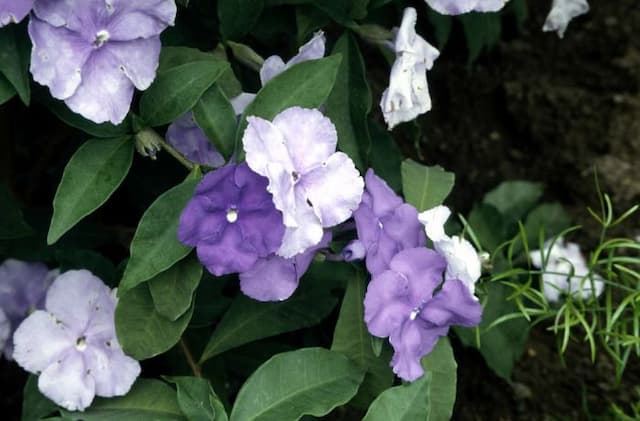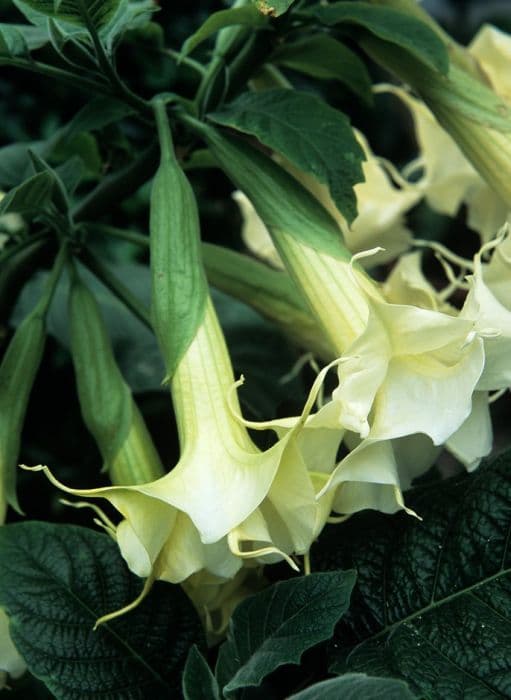White Potato Vine Solanum laxum 'Album'

ABOUT
The Solanum laxum 'Album', commonly known as the White Potato Vine, is an attractive climbing plant known for its lush foliage and abundance of flowers. The leaves of this vine are dark green, glossy, and typically have pointed tips with slightly wavy edges. The plant's most striking feature is its flowers. They bloom profusely, producing star-shaped white blossoms that have a subtle, fragrant scent. At the center of each flower, tiny yellow stamens add a delicate contrast to the bright white petals, creating a charming effect. As a vigorous climber, the White Potato Vine often features long, twining stems that are well-suited for training along fences, trellises, or arbors. This plant tends to grow quite full and bushy, which makes it an excellent choice for creating a green, leafy backdrop or for covering unsightly elements in gardens and landscapes. The overall visual impression of the Solanum laxum 'Album' is one of airy elegance and a profusion of white, providing a cool and soothing color palette that can complement various garden styles.
About this plant
 Names
NamesFamily
Solanaceae.
Synonyms
White Potato Vine, Potato Vine.
Common names
Solanum jasminoides, Solanum laxum.
 Toxicity
ToxicityTo humans
Potato vine (Solanum laxum 'Album') is considered toxic to humans. The plant contains solanine, a toxic alkaloid. If ingested, parts of the plant can cause symptoms such as nausea, vomiting, abdominal pain, diarrhea, headache, and dizziness. In severe cases, ingestion can lead to more serious neurological symptoms such as paralysis or respiratory problems. It is important to avoid eating any part of the potato vine, and to keep it out of reach of children who might accidentally ingest it.
To pets
Potato vine (Solanum laxum 'Album') is toxic to pets as well. Similar to its effects on humans, the solanine present in the plant can cause symptoms of poisoning in pets which might include vomiting, diarrhea, abdominal pain, lethargy, and weakness. More severe symptoms could involve tremors, seizures, and respiratory distress. It is crucial to prevent pets from ingesting any part of this plant and to seek veterinary attention immediately if you suspect your pet has consumed potato vine.
 Characteristics
CharacteristicsLife cycle
Perennials
Foliage type
Evergreen
Color of leaves
Green
Flower color
White
Height
6-15 feet (1.8-4.6 meters)
Spread
6-10 feet (1.8-3 meters)
Plant type
Climber
Hardiness zones
9
Native area
South America
Benefits
 General Benefits
General Benefits- Aesthetic appeal: Its white flowers and lush green foliage add beauty to gardens.
- Attracts pollinators: The blooms attract bees, which help pollinate other plants.
- Growth habit: Its climbing nature allows it to cover unsightly fences or walls.
- Easy to care for: It's generally low-maintenance, requiring minimal attention once established.
- Fast growth: It can grow quickly to provide coverage or fill in garden spaces.
- Versatile: Can be grown in containers or as a ground cover, as well as trained up supports.
- Durable: It's relatively hardy and can survive in a range of climates.
 Medical Properties
Medical PropertiesThis plant is not used for medical purposes.
 Air-purifying Qualities
Air-purifying QualitiesThis plant is not specifically known for air purifying qualities.
 Other Uses
Other Uses- Solanum laxum 'Album', commonly known as White Potato Vine, can be used in floral arrangements due to its delicate, star-shaped flowers and lush foliage, adding texture and volume to bouquets.
- The vine's dense growth habit allows it to be used for privacy screening, rapidly covering fences or walls to provide seclusion in gardens and outdoor spaces.
- Due to its twining nature, White Potato Vine can be trained to grow over arbors or pergolas, offering shade and a charming backdrop for outdoor seating areas.
- The plant can be cultivated in hanging baskets where its cascading growth can be appreciated, making it ideal for balconies and patios.
- White Potato Vine can be used in topiary, with careful pruning and training, it can take on various shapes to add structural interest to garden designs.
- As an evergreen in milder climates, it offers year-round greenery which can be valuable in garden designs aiming for winter interest.
- The vine's ability to grow quickly makes it useful in covering unsightly features, such as old stumps or utility boxes, blending them into the landscape.
- Dried stems with mature berries can be used for creating rustic and natural-looking craft items or for adding an earthy touch to homemade wreaths.
- Its non-invasive nature makes it suitable for planting in pots near natural areas without the risk of it escaping cultivation and becoming a weed.
- For educational purposes, White Potato Vine can be used in botany classes or workshops to illustrate plant growth habits, climbing mechanisms, and propagation techniques.
Interesting Facts
 Feng Shui
Feng ShuiThe White Potato Vine is not used in Feng Shui practice.
 Zodiac Sign Compitability
Zodiac Sign CompitabilityThe White Potato Vine is not used in astrology practice.
 Plant Symbolism
Plant Symbolism- Mystery and Concealment: Solanum laxum 'Album', commonly known as White Potato Vine, can symbolize mystery due to its fast-growing nature and ability to create dense foliage, often hiding what's beneath.
- Adaptability: The versatile growth habit of this plant, which can thrive in Various conditions, symbolizes adaptability and the ability to thrive in changing environments.
 Water
WaterThe White Potato Vine requires consistent moisture, and it's essential to water it when the top inch of soil feels dry to the touch. Generally, this will mean watering the plant once or twice a week during active growth periods, depending on the climate and weather conditions. Use a gentle stream of water to avoid disturbing the soil or damaging the plant. Each watering should thoroughly saturate the soil, providing approximately one to two gallons of water per session, ensuring that the plant has enough moisture to support its vigorous growth without becoming waterlogged.
 Light
LightWhite Potato Vine thrives in bright, indirect light, or partial shade. Ideal placement is in a location that receives morning sun and afternoon shade, as harsh afternoon sunlight can damage the foliage. A spot that mirrors these conditions will help the vine grow vigorously while maintaining healthy leaves and abundant flowering.
 Temperature
TemperatureThe White Potato Vine prefers a temperate climate with ideal growth temperatures between 60 to 80 degrees Fahrenheit. It can tolerate minimum temperatures down to around 50 degrees Fahrenheit and a maximum of about 90 degrees Fahrenheit, but extreme temperatures either way should be avoided to keep the plant healthy.
 Pruning
PruningPruning the White Potato Vine helps maintain its shape, control its size, and encourage more abundant flowering. It's best to prune in late winter or early spring before new growth begins. Cut back the stems to a healthy bud to invigorate the plant and keep it from becoming too tangled. Pruning can be done annually or biannually, depending on the desired size and shape of the vine.
 Cleaning
CleaningAs needed
 Soil
SoilPotato vine (White Potato Vine) thrives in well-draining soil with a pH between 5.5 and 7.5. A mix containing equal parts of potting soil, peat moss, and perlite or sand would be ideal to ensure proper drainage and aeration. To promote healthy growth, ensure the soil is rich in organic matter and maintain a balanced moisture level.
 Repotting
RepottingWhite Potato Vine should be repotted every 2-3 years or when it outgrows its pot. It is important to increase the pot size gradually to prevent stress on the plant and to use fresh soil mix when repotting to replenish nutrients.
 Humidity & Misting
Humidity & MistingWhite Potato Vine prefers moderate to high humidity levels. Aim for a humidity level of 40-50% to keep this plant healthy. It will tolerate lower humidity but thrives with increased moisture in the air, which can be achieved through regular misting or a humidifier.
 Suitable locations
Suitable locationsIndoor
Place White Potato Vine in bright, indirect light and keep soil moist.
Outdoor
Grow in full sun to partial shade and protect from strong winds.
Hardiness zone
9-11 USDA
 Life cycle
Life cycleWhite Potato Vine (Solanum laxum 'Album') begins its life as a seed, germinating in warm, moist soil where it develops a root system and sprouts its first pair of leaves. As a fast-growing perennial vine, it enters a vegetative stage, producing a profusion of foliage and, in the right conditions, can become quite expansive. The plant then enters its flowering stage, typically during warmer months, presenting clusters of star-shaped, fragrant white flowers that attract pollinators. After pollination, the flowers may develop into small, inedible berries. White Potato Vine may experience a period of dormancy in cooler climates or during the winter months. Given the right care and conditions, the vine can live for several years, regenerating and flowering annually.
 Propogation
PropogationPropogation time
Spring-Early Summer
The most popular method of propagation for Solanum laxum 'Album', commonly known as white potato vine, is through semi-hardwood cuttings. To propagate from cuttings, choose a healthy section of semi-hardwood stem that is 4 to 6 inches long (10 to 15 centimeters) and remove any flowers or fruit. Cut the stem just below a leaf node, where the concentration of rooting hormones is high. Strip the leaves from the lower half of the cutting to expose the nodes where roots will form. Dip the cut end into rooting hormone powder to enhance root development then plant the cutting into a pot filled with a mixture of peat and perlite or a well-draining potting mix. Keep the potting mix moist but not soggy and place the cutting in a warm area with indirect light. Roots typically establish within a few weeks, after which the cutting can be gradually acclimatized to outdoor conditions before being planted in its final location.









